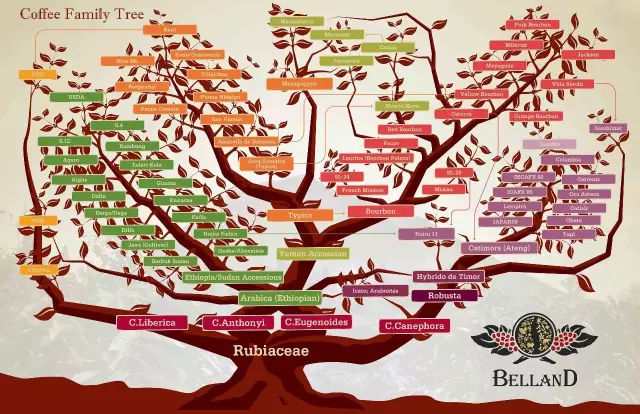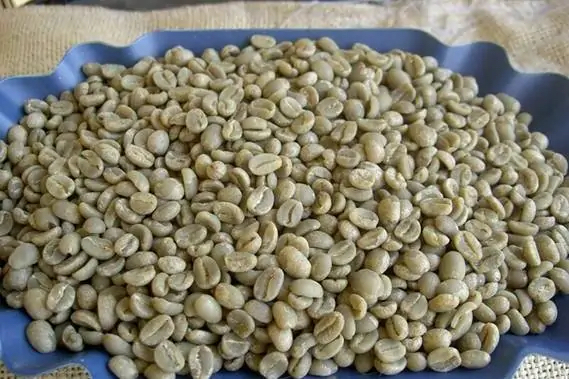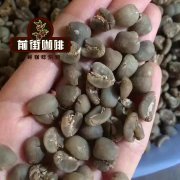Brief introduction of Arabica interspecies hybrid coffee bean flavor characteristics of new variety Ruilu 11 Carmont
What is a Cameroun hybrid coffee? What is Arabusta coffee? How did these interspecific hybrid coffee beans develop? Is there any difference between flavor and taste and traditional beans?
With these questions, let's explore Arabica's interspecific hybrid series of beans.

Timorese hybrid species (Hibrido de Timor)
Basta has a diploid body and a 22-year-old color. it is known for its strong disease resistance, high yield but vulgar taste. Arabica is tetraploid and has 44 chromatids. it is famous for its weakness and sickness, low yield and elegant taste. People are divided into different species, and there are very few fertile varieties in hybrids, but this freak has been found in Timor.
Indonesia's 1978 approach to Timor mixed-race rent, known as Tim Tim: at first, the taste of Phoenix was not good, but after many years of treatment, the taste of humiliation was greatly improved, and it became one of the main products in the use of Germanic special services. It is worth noting that. Several kinds of Arabian Timor abia have entered the boutique market in Timor's high-altitude mountain area. Don't get confused with the Timorese hybrid. A Timorese hybrid has been acquired in Taiwan and China, which is generally called low-grade Arabica.
Alabasta (Arabusta)
On the face of it. This is different from the Timorese hybrid mentioned above, which is of the same breed as Arabica and Basta. Alabasta did not rub it together naturally, but with the help of genetic engineering, colchicine, a scientific household, broke the body of Basta cell division, doubling the dye to 44 years before it could produce a stable variety with Arabica, but Alabsta's genes, substitutes, and flavors were closer to those of Alabasta, and Alabasta was worse than Timorese hybrids.
Qahun (Catimor)
After the discovery of the Timorese hybrid by Dr. Cristiola of Portugal, in 1959, a new hybrid of Caturra X Timor Hybrid and Timor was successfully developed, which certainly has the vulgar taste of Basta, but it has a strong resistance to disease. From 1970 to 1980, farmers in various countries were encouraged to replace the old bourbon, Limbica and Kaddura. When the cultivation of coffee ball entered a new era, agricultural research units in Brazil, India and Costa rica introduced different forms of Carmorn, such as Catimor T5175, T8667, LC1662 Little H306 and so on. Card Timor has become the most expensive high-product species in ball cultivation, and various countries have fallen into the tide of Timor-Leste. However, the good times will not last long, and farmers will find that their production capacity is declining year by year, and their life is shorter than that of Bourbon or bourbon, so they have to replace them regularly. To make matters worse, the devil's tail with thick beans can only serve as low-and middle-level beans, unable to enter the boutique circle.
However, Indonesia is the only exception. Indonesia calls Catimor "Ateng". As long as you pick out the defective beans of Ateng, the taste is thicker and thicker than that of Cameroun.
Ateng has successfully entered the international boutique market. Indonesia's Ateng is the most delicious Karamun in the world. In recent years, coffee experts at SCAA have studied in depth the "Ateng" and "Tim Tim" of Lake Tawa in Indonesia and Lake Toba in Hebei Province, and find out why they taste better than the same varieties outside Indonesia. The conclusion is that "Ateng" naturally backcrossed with other Arabica, coupled with special soil and water and special planing methods to wash the devil's tail in Kadoun.
Manteki, the most beloved of the Chinese people, is actually a mixture of Ateng, Tim Tim and Limbica, coupled with Indonesian soil and water and ploughing methods, showing the smell of soft acid, fragrance, low depth, Chinese fir, herbs and sticky regions.
Iraq 11 (Ruirul1)
In 1985, the Guilu Coffee Research Center in Kenya produced a hybrid of Timorese and Malaysian native Arabica, that is, the well-known Islamic Republic 11 (Timor Hybrid X Rume Sudan). The former can resist the disease, while the latter have good immunity to the disease. The government has created a variety of super products that can not be invaded by all diseases, but after it was put on the market, it became very popular, and it is also a kind of high-yield and high-taste product. It can produce 4.6m / m of raw beans, which is much higher than SL28's 1.8m / m. However, the beauty boutique industry does not like it, and the research center is not convinced. In recent years, it has returned to the "body" of SL28, a variety of products made in China and Iraq, saying that it will create a super coffee that is productive, disease-resistant and delicious. "
Batian (Batian)
Sure enough, in September 2010, the Coffee Research Foundation (Coffee Research Foundation, CRF) in Kenya announced that it had developed a disease-resistant, prolific and delicious new breed of Batian, called SL28 x Ruirull, and that it would be planted before the end of the year to save the output of Ken.
It is reported that Batian can be produced by the end of the year, with 5 metric tons of raw beans per metric meter. It is more productive than Yilu 11 and is resistant to scab and coffee fruit disease. Batian's tails are as bright as turquoise, but a few of them are cyan and tall, similar to SL28, and the beans are bigger and better than Ruirul1SL28SL34.
Due to the poor performance after the launch of Iran 11, the fund will be run by Joseph Kimemia, who said: "after more than a decade of research, Batian has been nurtured and will replace the intriguing Shiru 1. However, SL28 is the most delicious coffee in Kenyan, but Batian tastes more delicious, so it is named after Batian, the main peak of Mount Kenyan. Is Batian really the "super coffee" that the world is waiting for? Will the taste be affected by SL28 and SL34? see Zhenzhang after 2012-2013.
Colombia
Of the hybrids produced by Colombia in 1982, her parents are still Kaddura and Timor, but the bureau claims that unlike the general Kadulado, she is a hybrid of Cabernet and elegant Kadulado, washing the taste of Timor every year. It took more than a decade to develop a tasteless flavor, which is why it takes the country's name to be a signboard, but to this day, the boutique industry is still insensitive, thinking that the taste is popular in Colombia's national statistics card.
In recent years, the Bureau has also launched an improved version of the Gobbi, which is named Castillo, which ensures that the Colombian and Elaraby-Cadodei have mixed blood, but it is still popular in the "extraordinary Cup", and the fine goods industry is still looking forward to it. At present, Colombia still takes Kaddura and Costa Rica as the main products, and there are few Bibi cards. Fortunately, Kaddura of Colombia is very popular. In 2009 and 2010, he failed to win the title of "Coffee of the year" by SCAA.
Ikari (Icatu)
This is a breed of rice bred in Brazil for many years with the mixed blood of Alabustao New World and Cadulado, and its consanguinity is Arabuta x Caura x Mundo Novo super-class variety. In 1993, Brazil officially announced that the yield of varieties planted to the people was 30% to 50% higher than that of the main varieties in the New World, and it was resistant to typhoid disease. The sex and genetic structure of Ikara is similar to that of Arabica, and the devil's tail is very clean. He won the 10th-10th place in the Brazilian "extraordinary Cup" in 2006 and 2007, and finally got rid of the stigma of mixed blood. The beans of Icarus are large, and there are also some of them, which are mixed with Bourbon and are very sweet.
Bata (Obata)
This is a fine variety cultivated by Brazilian scientists with Timor as a breed, and it won the second place in the 2006 Brazilian "extraordinary Cup". The blood system of Sabata is even more complex, which is Sarchimor (Villasarchi X Timor) X Catuai. The two new varieties, Ikara and Zabata, are not only good in taste, but also strong in disease resistance, and the number of growers is increasing year by year.
Rasuna
Indonesia has responded to the chemical disease-resistant strain introduced after 1970, which is known as Typica X Catimor, but still has a devil's tail, and has been replaced by the popular Ateng series since 1990. Lei Hina is rare at present, but she occasionally appears in the beautiful boutique market.
Slection 9
It is named SIn 9, which was bred in India in 1979. Its blood system is SIn8 x Tafarikela. India's SIn 8 is also known as Qatar, while Tafarikela was quoted from Ethiopia in 1975 and has something to do with the well-known Geisha.
It is said that SIn 9 is a hybrid of wild Arabica with strong disease resistance and good taste. It won the first prize of the 2002 Indian Cup. It is a well-known Indian delicacy and tastes a bit like Barnabas Geisha.
The permanent Bureau of India has made great efforts to promote the rent of Wu Pinrent. Fine coffee has been made.
S795 (Jember)
This product is bred in India in 1946 with a blood system of 98 x Kent. The former S288 is the first generation of S26, while iS26 is the natural and elegant product of India's early Campirika and Elaraby tECofa Lbera x Cofa Arabia: but the first generation of S26 Yue S288 is not good-looking and smells like Birika.
Indian scientists have mixed S288 with Kent and gave birth to S795 with large and delicious beans. It is said that S795 has good genetic stability and is currently the main breed of fine coffee in India. In recent years, it has been transplanted to Indonesia and Central and South America, and has been very popular. It is also one of the main varieties of Lavisi Toraja in recent years.
S795 is known as Jember in Indonesia, named after the Coffee Coffee Research Center (Jember Coffee Research Center) in Java from the Indian bow later sent to farmers. The Indonesian Bureau is making great efforts to promote this variety.

Important Notice :
前街咖啡 FrontStreet Coffee has moved to new addredd:
FrontStreet Coffee Address: 315,Donghua East Road,GuangZhou
Tel:020 38364473
- Prev

The Development and Flavor characteristics of Arabica variant Coffee Bean what is the New World of Elephant Bean?
In addition to Central American and Ethiopian geisha coffee, seven Arabica intraspecific mixed bean species are also introduced. Do you know what a hybrid coffee bean is? In fact, it is very simple that Arabica and Arabica are natural hybrids of different varieties under Arabica. Arabica is characterized by self-pollination of the same plant, while Haohua pollination of the same plant is abnormal.
- Next

Taste characteristics of Colombian Coffee Bean producing areas and their relationship between Coffee Flavor and growing Environment
How many coffee growing areas are there in Colombia? Sour Colombian coffee that makes you comfortable, good coffee will make you feel that the sweet and sour taste of the entrance is easy to accept. Colombian coffee starts with the first taste of caramel, and as the temperature drops, the nutty flavor will gradually appear. The whole coffee makes people feel very comfortable. More suitable for the taste of the public, the use of Colombian coffee
Related
- Detailed explanation of Jadeite planting Land in Panamanian Jadeite Manor introduction to the grading system of Jadeite competitive bidding, Red bid, Green bid and Rose Summer
- Story of Coffee planting in Brenka region of Costa Rica Stonehenge Manor anaerobic heavy honey treatment of flavor mouth
- What's on the barrel of Blue Mountain Coffee beans?
- Can American coffee also pull flowers? How to use hot American style to pull out a good-looking pattern?
- Can you make a cold extract with coffee beans? What is the right proportion for cold-extracted coffee formula?
- Indonesian PWN Gold Mandrine Coffee Origin Features Flavor How to Chong? Mandolin coffee is American.
- A brief introduction to the flavor characteristics of Brazilian yellow bourbon coffee beans
- What is the effect of different water quality on the flavor of cold-extracted coffee? What kind of water is best for brewing coffee?
- Why do you think of Rose Summer whenever you mention Panamanian coffee?
- Introduction to the characteristics of authentic blue mountain coffee bean producing areas? What is the CIB Coffee Authority in Jamaica?

